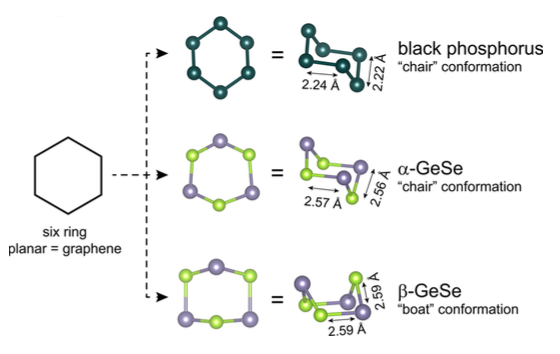Scientists discover new “boat” form of promising semiconductor GeSe
Princeton researchers have discovered a new form of the simple compound GeSe that has surprisingly escaped detection until now. This so-called β-GeSe compound has a ring type structure like graphene and its monolayer form could have similarly valuable properties for electronic applications, according to the study published in the Journal of the American Chemical Society.
Graphene has been hailed as a two-dimensional wonder material for electronics but its lack of a band gap has hindered its development for devices. As such, a closely related material, black phosphorus, has been receiving intense research attention because it has a small band gap and a high charge carrier mobility, and can easily be reduced to nanometer thicknesses. The researchers calculated that GeSe is highly analogous to black phosphorus and can be considered a pseudo-group-V element.
Under extreme pressure, black phosphorus is transformed into a simple cubic form, so the team wondered if the same could be done to GeSe and heated the abundant α-GeSe form of the compound to 1200 °C under 6 GPa of pressure or 60,000 times atmospheric pressure.
“What we found was not only a new kind of GeSe—which is already unconventional by itself in that you rarely find new binary compounds anymore—but that it has this uncommon ‘boat’ conformation that we were amazed by,” said first author of the study Fabian von Rohr, a postdoctoral researcher in the laboratory of Robert Cava, the Russell Wellman Moore Professor of Chemistry.

Image credit: Cava lab
β-GeSe’s rare “boat” form is likely stabilized by the slightly smaller distance between its layers, while black phosphorus and α-GeSe exist in standard “chair” conformations. The difference in structures gives rise to the compounds’ different electronic properties. The researchers found that β-GeSe possesses a band gap size in between that of black phosphorus and α-GeSe, which could prove promising for future applications. GeSe is also an attractive material for electronics because it’s robust under ambient conditions while black phosphorus is reactive to both air and water.
Read the full article here:
von Rohr, F. O.; Ji, H.; Cevallos, F. A.; Gao, T.; Ong, N. P.; Cava, R. J. “High-Pressure Synthesis and Characterization of β–GeSe—A Six-Membered-Ring Semiconductor in an Uncommon Boat Conformation.” Journal of the American Chemical Society 2017 139, 2771. This work was supported by the Gordon and Betty Moore Foundation, EPiQS initiative, Grants GBMP-4412 and GBMF-4539.
